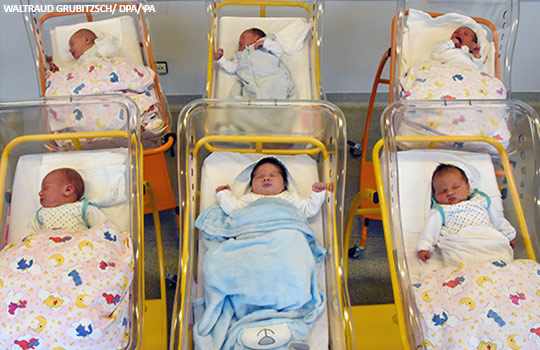 One of my medical students has a fantastic story to explain why she wants to specialise in obstetrics and gynaecology.
One of my medical students has a fantastic story to explain why she wants to specialise in obstetrics and gynaecology.
As a pre-clinical medical student, before she had ever stepped into a maternity ward in Ireland, she went to work in a developing country. This student quietly watched and helped where she could. She saw women arrive to the hospital on the back of a motorbike, or cart, or after walking 30 miles or more in labour. Women who delivered with only the help of a birth attendant as there was just one doctor for the entire hospital. Women who had been fully dilated for a couple of days before delivery and who developed horrendous, life changing fistulae. Women and babies who died during labour and after delivery. A “good” month there was when the number of maternal deaths was in single figures.
This is a world that most of us have never experienced unless we deliberately travel to work in these areas. It is a world reflected by the population of the WOMAN trial, which analysed the effect of early administration of tranexamic acid on the management of major obstetric haemorrhage (MOH) across 21 countries. This is a world where one in eight women with MOH delivered their baby at home and had to be transferred to hospital for care. The trial was extended when the study team realised that many women were being considered for the trial while they were being prepared for theatre for a hysterectomy. In many maternity units, a hysterectomy is one of the only options to manage a mother who is bleeding, while in developed countries this is usually a treatment of last resort.
For anyone who has worked in this world, nature is not maternal, and my student was exposed to significant maternal, fetal, and neonatal morbidity and mortality. It is a reminder of the time, not long ago, that women in developed countries genuinely dreaded pregnancy for the risks it carried.
The student returned home to Ireland to start clinical placements and witnessed a ward where women and babies dying was a rarity rather than a regularity. She met women who had a MOH where the entire multidisciplinary team swung into place in a coordinated fashion and managed care in both an evidence based and compassionate way. Women with serious medical conditions—diabetes, congenital heart disease, nephropathies, transplants—who chose to become pregnant, or chose not to continue a pregnancy, and received high quality care. Women who underwent an antenatal ultrasound assessment so that a congenital abnormality would be diagnosed early and appropriate management initiated, allowing the mother to give birth in a unit where the baby could be cared for. The population characteristics were different—more affluent, well nourished, informed women—but so too was the care provided by the many skilled midwives, doctors, and allied health professionals available. And, like many of us, she realised that if she too became part of this team then she could make a difference.
One of the many reasons that I love this story is because of the timeline of exposure. My first experience of maternity care was within the developed world followed by the developing world. Consequently, my first time in a labour ward and antenatal clinic in the latter was difficult when I saw the number of women presenting, the challenges for staff, and the conditions in which they practised—and compared these to my own relatively rarefied unit. In comparison, this student had as her first experience what happens with minimal support as a baseline, and her comparison was what can happen with good nutrition, high quality education, investment, and care. She saw what happens in nature first, and then what happens when the layers of support, care, free healthcare, and accessibility are added.
The one disadvantage of this approach is that it can be difficult to deal with complaints where safe care delivered a healthy baby and mother, but that woman reported her experience to be suboptimal—where she didn’t get a private room after delivery, or her birth plan didn’t work out, or when a husband stopped his wife from asking for analgesia in labour, for example. It can sometimes be difficult to have full empathy when you have memories of a mother dying, a stillborn infant being delivered, or caring for a child bride who had female genital mutilation.
So how do I reconcile these contrasts in order to provide the care that my patients need and deserve? And how did I help my student do the same? What I explained is that I have learnt over the years to remind myself of Maslow’s hierarchy of needs—the concept that at a baseline level we have the need for food, water, and warmth, then safety, belongingness, and esteem. At the height of the hierarchy is self-actualisation: achieving one’s full potential. Women who feed back about “obstetric violence” because their babies did not have delayed cord clamping due to the need for neonatal resuscitation have had their baseline needs met. If this is the worst thing that happens in the birth of their child, then let us still learn from this valid experience, change, and move on.
What I have learnt from all these experiences and reflections is what a privilege it is for me to have had a pregnancy in the developed world, where maternity care is safer and we can concentrate on the higher levels of hierarchy. This sense of comfort is balanced by the humility of knowing that at any time nature can bring a woman right down the hierarchy of needs to the fundamentals: pregnant women facing homelessness, women and partners newly unemployed, an abruption, an intrauterine death, an eclamptic fit. Our focus in the developed world is now on bringing the balance back from too much medical care rather than worrying about too little, but the fulcrum swings differently elsewhere.
It is an aspiration that women and families in other countries can have these fundamental needs met, so that they can concentrate on self-actualisation while having the full safety net of medical care. Unfortunately, at the current rate of progress it will be “more than 160 years before a pregnant woman in Africa has the same chance of her baby being born alive as a woman in a high income country today.” A sobering conclusion.
Mary Higgins is an obstetrician at the National Maternity Hospital, University College Dublin.
Competing interests: None declared.
